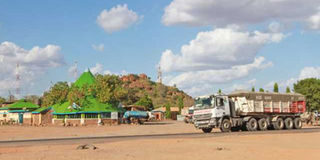Rise and fall of Mtito Andei: How SGR has affected town’s fortunes

A truck moves past Migingo area in Mtito Andei. PHOTO | PIUS MAUNDU | NATION MEDIA GROUP
What you need to know:
Mtito Andei is the latest trading centre along the corridor to suffer an economic slowdown linked to the realignment of a section of the Mombasa-Nairobi highway and the completion of the SGR.
The town’s revenue base is pegged on bars, restaurants and hotels, which largely depend on passengers in buses and lorry drivers and conductors.
Had the asbestos not been exhausted and its harmful effects publicised, Mtito Andei would probably have grown into a big industrial town along the railway line. But decades later, it is slowly dying, thanks to another train track.
Derived from mutitu wa ndei — Kamba for forest of vultures — Mtito Andei was born in the 1800s as a barter trade station for long-distance traders. Kamba traders would travel to the Coast with ivory and other items, which they exchanged for other things with Arab merchants.
RUINS
The builders of the Kenya-Uganda Railway in the 1890s had designated Mtito Andei as a railway construction hub and later upgraded it into a railway station. Aided by the railway network, mineral prospectors descended on the region searching for minerals. The discovery of asbestos was a big boost for the nascent town.
In 1930, the colonial government issued Kenya Asbestos Company exclusive rights to mine the mineral at Kinyiki Hill in Kathekani, on the fringes of Mtito Andei. It was also granted rights to prospect for other minerals. Another licence to prospect had been given to geologist C.G. Powell in January 1936.
With the closure of these mines, all that remains today are the ruins of what used to be a factory, a bay for loading the commodity onto trains and staff quarters. It is not clear why Kenya Asbestos Company went under, in the process dimming the economic prospects of hundreds of households.
Nonetheless, Mtito Andei expanded steadily and became a stopover on the Mombasa-Nairobi highway. With that came restaurants, hotels and banks.
“The modern restaurants have made the town the biggest stopover for buses and trucks in this region,” said Mr Pascal Kyule, a former Mtito Andei chief who is a businessman in the town.
It is also a gateway to Tsavo West National Park.
DECLINE
But with the launch of the Standard Gauge Railway (SGR), the town is facing a decline in fortunes.
Residents are now protesting a bid by the Makueni County government to downgrade Mtito Andei to a lower tax regime that signals imminent underdevelopment in the town, according to residents.
Mtito Andei is the latest trading centre along the corridor to suffer an economic slowdown linked to the realignment of a section of the Mombasa-Nairobi highway and the completion of the SGR.
The Makueni County 2019-2020 Finance Bill proposes, among other things, to move Mtito Andei from Zone A to Zone B — a lower tax zone in urban classification — following incessant complaints that business in the town has slumped.
While traders are excited about the prospect of paying less tax, other stakeholders feel the downgrading will condemn the town to underdevelopment.
“Downgrading risks depriving Mtito Andei of mega infrastructure projects that municipalities attract,” said Mr Swaleh Makumi, the chairman of an association of traders in the town.
But he admits that business and other economic activities in and around the town have declined following the completion of the SGR.
PASSENGERS
Situated midway between Mombasa and Nairobi, Mtito Andei was the headquarters of the defunct Mtito Andei Town Council. The town’s revenue base is pegged on bars, restaurants and hotels, which largely depend on passengers in buses and lorry drivers and conductors.
An ambitious government project to realign the Thange-Mtito Andei section of the Mombasa-Nairobi highway in 2000, ostensibly to avert frequent road accidents, led to a business boom in Mtito Andei. Most of the traffic was directed to the town after the neighbouring Machinery, Kwa Kinyuti, Kwa Kithokoi, Kambu and Hillside markets were bypassed by the highway.
The good tidings changed in 2017 when the new railway line was commissioned. With the SGR, the number of buses stopping in the town dropped significantly following the introduction of the Madaraka Express, the passenger train that runs on the new railway line.
“Mtito Andei entertainment joints and eateries record low patronage following the completion of the new railway line, which has taken many lorries off the highway,” said Mr Kyalo Laiti, a local businessman who served as the last chairman of the defunct Mtito Andei Town Council.
NIGHTLIFE
The town’s nightlife glory is no more, with neighbouring Makindu and Emali now more popular with patrons and partygoers.
Already, traders at Machinery and Kambu are reeling from the road realignment shock. Their colleagues at Hillside, Kwa Kithokoi and Kwa Kinyuti, which also depended almost exclusively on the busy highway, have closed shop after the markets turned into ghost towns.
Mr Kisivo Mulei, the owner of Okay Hillside Hotel — where more than 1,000 passengers had meals, drinks and snacks daily — said the economic crunch has reduced his establishment to a shell.
Tips for bus drivers
Mr Benson Musyoka, who owns rental houses at Hillside shopping centre, added: “Tenants have vacated all my 60 rooms.”
CIGARETTES
A spot check by the Nation revealed that most restaurants tip bus drivers with a plate of food of their choice, a packet of cigarettes, a bottle of water and Sh200 to drop off passengers at their premises. This “culture”, which is as old as the town, is partly to blame for the economic decline of Mtito Andei, former Kibwezi MP Onesmus Mboko said.
“Since it only takes a little motivation for bus drivers to get many clients at their doorsteps, most service providers will tend to be less bothered with provision of quality service,” he said. “They are more concerned with motivating the bus drivers than satisfying the clients. This approach to business is not sustainable.”
That notwithstanding, it seems the town that was born from one railway line might die because of another track.





